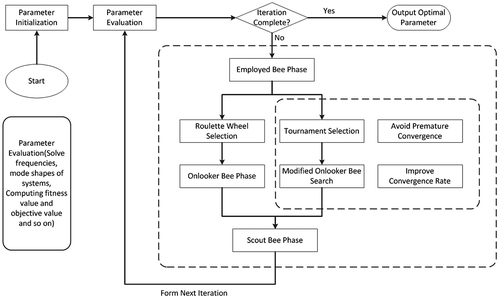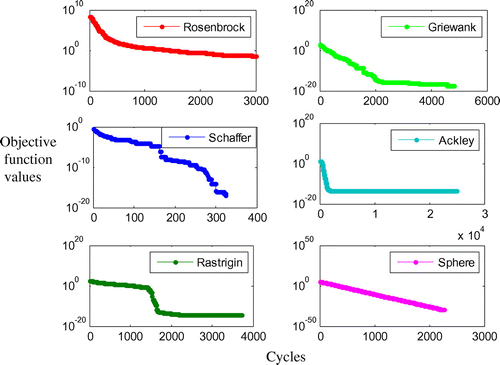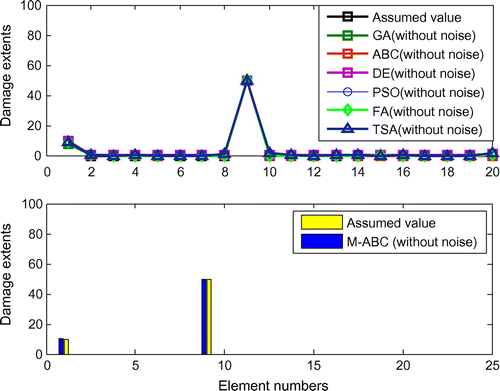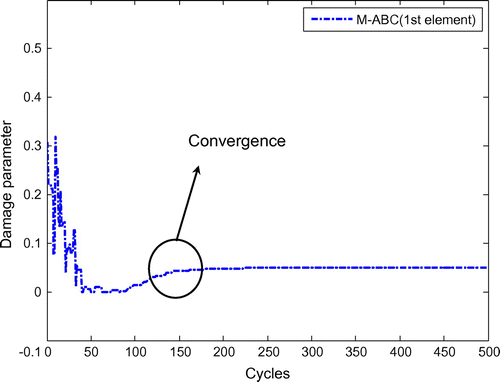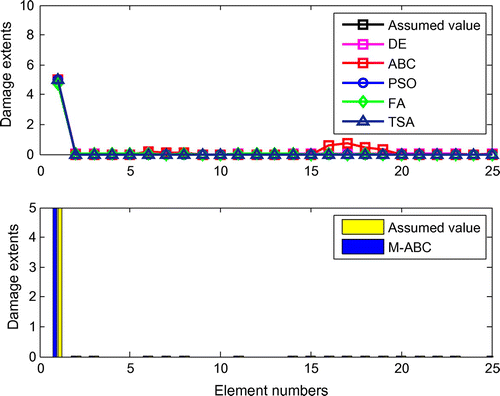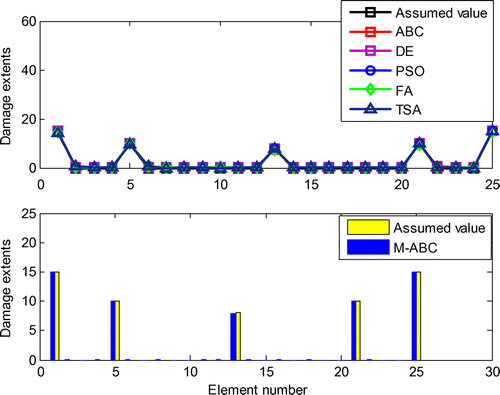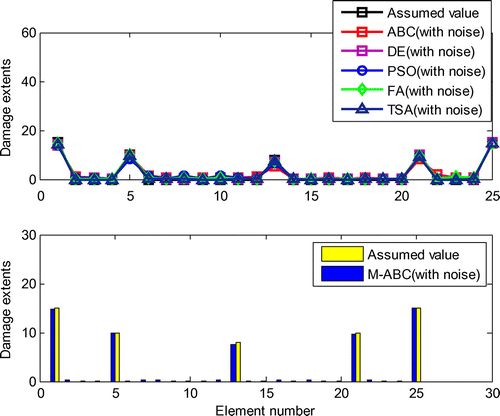 ?Mathematical formulae have been encoded as MathML and are displayed in this HTML version using MathJax in order to improve their display. Uncheck the box to turn MathJax off. This feature requires Javascript. Click on a formula to zoom.
?Mathematical formulae have been encoded as MathML and are displayed in this HTML version using MathJax in order to improve their display. Uncheck the box to turn MathJax off. This feature requires Javascript. Click on a formula to zoom.Abstract
A method for structural damage identification based on a modified Artificial Bee Colony algorithm is presented. A new formula is introduced to the onlooker bee phase to improve the convergence rate and the Tournament Selection Strategy is adopted instead of roulette to enhance global search ability of the algorithm. Test functions are introduced as benchmarks to verify the proposed algorithm. And then two numerical examples, including a supported beam and a plate, are conducted to investigate the efficiency and correctness of the proposed method. Final estimated results show that the present technique can produce more accurate damage identification results, comparing with other evolutionary algorithms, even with a few noise contaminated measurements.
AMS Subject Classification:
1. Introduction
Many civil structures are subject to damage due to the factors like earthquake, impact, fatigue and corrosion. Since the strict requirements for high-quality and reliable structural components, the structural health monitoring has become a major research topic in civil engineering over the past few decades. In particularly, the vibration-based damage identification method based on its conveniently operation, gains more and more attention.
Most researchers have proposed methods for the detection of the existence of structural damage via monitoring the change in structural responses [Citation1–3]. More recently, Li and Hao [Citation4] utilized continuous wavelet transformation and Hilbert-Huang transformation to analyse the measured dynamic responses and to identify the damage of connectors in the composite bridge model under moving loads. Furthermore Li et al. [Citation5] regarded vertical deflections and relative displacement as the input to solve crack identification problem. All these studies have acquired a good estimated result.
On the other hand, from a mathematical view, this problem can be viewed as a nonlinear optimization problem by defining an objective function related to structures in advance [Citation6–8], and optimal techniques can be applied to tackle it. The drawback of classical optimization methods and sensitivity methods is usually gradient-based and requires a good initial value [Citation9,10], which restricts the applications of these methods. By contrast, heuristic algorithms can overcome these flaws and thus gaining their popularity in dealing with optimization problems. For examples, Friswell et al. [Citation11] proposed a combined genetic and eigen sensitivity method to identify a linear structure. Li et al. [Citation12] presented a symbolization-based differential evolution strategy to estimate structural system parameters with and without noise pollution. Dackermann et al. [Citation13] used cepstrum and artificial neural network procedure to solve parameter identification of structural relying on response-only measurements. In order to identify multiple damages in structures, Guo and Li [Citation14] adopted a two-stage damage identification technique by utilizing evidence fusion and improved particle swarm optimization. This research all acquired satisfactory results.
1.1. A brief literature review on ABC algorithm
Apart from the techniques mentioned above, Artificial Bee Colony (ABC) algorithm is another swarm intelligence technique, which was suggested by Karaboga to solve numerical optimization problems. This algorithm is inspired by the bee colony’s behaviour of seeking high-quality food source, and it is a stochastic algorithm with simple structure and good robustness. Karaboga and Basturk [Citation15] adopted it to optimize multivariable functions and also compared their results with those calculated by GA, DE, PSO and so on. It is shown that the ABC algorithm has a better ability to obtain the global optimal solution. For the purpose of enabling this method equipping with better global optimal ability, Zhu and Kwong [Citation16] added the global best message in the bee colony to the feasible solution updating equation in the method named after gbest-guided ABC. Banharnsakun et al. [Citation17] modified the ability of convergence of ABC to a global optimum via using the best-so-far selection for onlooker bees, and they tested the performance of their method on numerical benchmark functions and image registration. Gao et al. [Citation18] introduced crossover operator for ABC and called the improved version as CABC. Kiran et al. [Citation19] suggested a multiple solution update rule for ABC and final estimated results for numerical optimization are more satisfactory. In another study, Kiran and Gunduz [Citation20] introduced the neighbour search strategy of genetic algorithm into ABC and the exploitation ability of algorithm gets enhanced. Lately, this technique has extended its application in engineering field. Sonmez [Citation21] used the ABC algorithm together with a penalty function method to minimize the weight of truss structure. Eom and Han [Citation22] also introduced the ABC algorithm to the field of topology optimization of nonlinear structures. Omkar [Citation23] applied the ABC algorithm for design of composite structures.
Ata and Coban [Citation24, 25] adopted ABC to realize the design of a nonlinear inverted pendulum. Erçin and Çoban [Citation26] also applied the ABC to estimate linear dynamic systems. Sun et al. [Citation8] improved the ABC algorithm with a nonlinear factor to enhance its balance of global and local searches and then used it to solve the structural identification problem based on time domain response. Sun and Betti [Citation27] also used the ABC algorithm combined with Nelder-Mead simplex method to detect damages in building models. These studies mentioned above provide a new way of dealing with conventional optimal problems in engineering.
1.2. Main work of the study
This paper mainly deals with the damage detection problem using an improved ABC algorithm based on an objective function established in frequency domain. Compared with the sensitive method [Citation3], the ABC has some advantages, (a) It dose not need gradient information; (b) It dose not require a good initial value. Besides, there are few papers related to its application in structural damage identification. In addition, to make ABC more powerful, the modification work is also a research priority, because it is widely accepted that the ABC algorithm are likely to be stagnant in some local optimal, which is similar to other swarm intelligence algorithms [Citation16–20]. In hope to avoid this shortcoming, two improvements are made on the original ABC algorithm, in which the tournament selection strategy is adopted instead of roulette wheel to enhance global search capability of the algorithm and a new formula is introduced to the onlooker bee phase to improve the convergence rate. The performance of the modified algorithm is illustrated in several test functions and two kinds of structures, i.e. a simply supported beam and a cantilevered plate. Comparing the results with those from other evolutionary algorithms, better identified results can be obtained from the modified ABC algorithm (M-ABC), which can reflect its potential to solve the problem.
2. Mathematical model
2.1. Parameters of damage
After finite element discretization, modal parameters of a structural system can be obtained from the eigenvalue equation(1)
(1)
where K and M are the global stiffness and mass matrices, respectively. ωi is the ith natural frequency and Φi is the corresponding mode shape.
According to continuum damage mechanics, damage can be expressed through a scalar variable αi with value between 0 and 1 [Citation28]. αi represents the ith element is intact while αi = 1 indicates that it is completely damaged. The global stiffness matrix Kd of the damaged structure can be expressed as
(2)
(2)
where kei denotes the ith elemental stiffness matrix and nel denotes the total number of finite elements.
2.2. Objective function based on the vibration data
Structural damage will lead to changes of natural frequencies and mode shapes of the structure, so on the other hand, we can use this modal data to formulate the objective function for damage identification. Usually, the modal assurance criterion (MAC) is used to establish the objective function
(3)
(3)
(4)
(4)
(5)
(5)
where and
are ith calculated and measured mode shapes. NF and NM are the numbers of natural frequencies and mode shapes used in calculation, respectively. It should be pointed out that the calculated natural frequency
and mode shape
are related to damage parameters [α1, α2 … αnel]. In the inverse problem, the damage vector is identified to indicate the damage extent of structure.
3. Algorithm for damage identification
3.1. Introduction to the Artificial Bee algorithm
The artificial bee algorithm is inspired by the behaviour of bee forage. When foraging, the bees are classified as scout bees, employed bees and onlooker bees. The foraging process starts in a colony by scout bees, exploring food source by moving randomly. At the entrance of the hive is a zone called dance-floor, where they communicate with each other via waggle dance in order to recruit other bees to go to the food sources. Their dances contain variety of information such as food quality, distance and so on. The onlooker bees watch many different dances and choose the best food source, then they will become the employed bees, going to the best food source and exploiting the better source in the neighbourhood around the destination. If they find a better place, they will give up the primary best place. If the employed bee can’t find better source after exploiting the several times, it will become the scout bee again, and continue to explore food randomly. In the algorithm, a parameter, limit is used to control the abandonment problem of the food sources. For every solution, the trial number of improvement is taken, in each cycle of the solution which has the maximum trial number and its trial number is compared with the parameter limit. If the limit value is reached, this solution is considered fully exploited and continues with a randomly produced new solution.
In ABC algorithm, a food source position is defined as a possible solution and the nectar quality of the food source matches the fitness of the related solution in optimization process. Because each employed bee is associated with only one food source, the number of employed bees is equal to the number of food sources.
The general structure of algorithm is introduced as follows.
3.1.1. Initialization phase
Food source is expressed as Equation (Equation6(6)
(6) ) in a random way
(6)
(6)
where m is an arbitrarily solution in the search space and ui, li represent the upper bound and lower bound of the parameter xm,j, respectively.
3.1.2. Employed bees phase
The scope of the employed bee is to find a better food source in the neighbour-hood of the food source (). It leaves the hive and finds the target point, beginning the food exploitation. Equation (Equation7
(7)
(7) ) is used to simulate its behaviour
(7)
(7)
where is a food source, φm,i is a random number in [−1, 1] and i is a randomly chosen dimension. After producing a new candidate source, its profitability is calculated accordingly, and greedy selection is utilized between
and
.
The fitness of each solution in this problem is calculated according to Equation (Equation8(8)
(8) )
(8)
(8)
3.1.3. Onlooker bees phase
The employed bees return home and share their food source information with the onlooker bees. They select the food source to exploit relying on the probability value pm(9)
(9)
where SN denotes the number of employed bees. (The quantity of employed bees is the half of the initial colony size.) After selecting a food source, onlooker bees will fly there to exploit a better food source. In the ABC algorithm, the behaviour is simulated by Equation (7). Then fitness value is calculated applying the greedy selection to produce better food source.
3.1.4. Scout bees phase
At the end of every cycle, the trial counters of all solutions are examined. Abandonment of the solution is determined as follows: if the solution couldn’t improve after limit times, the solution is abandoned and Equation (Equation6(6)
(6) ) is used to produce a new food source to replace the abandoned one. The limit parameter l is given as in [Citation15]
(10)
(10)
where D is the dimension of the problems, CS is the initial colony size.
3.2. A modified ABC algorithm
3.2.1. A new formula for the search behaviour of onlookers
In the real world of honey bees, an employed bee just exploits the food source which it visited before, but an onlooker bee selects a food source based on the dances of employed bees. When onlooker bees reach the region, they will examine food sources in the area and choose the best to exploit. Thus the behaviour of onlooker bees should be different from the employed bees. However in the original ABC algorithm, the formula used to simulate their actions are the same. To make the algorithm more similar with the real behaviour of bee colonies while collecting honey, inspired by Karaboga [Citation29], a new formula is introduced to express onlooker bee’s exploitation behaviour, given as follows
(11)
(11)
where denotes the best solution among the neighbours of
and itself. In order to define a neighbour, the Euclidean distance is introduced, and the Euclidean distance between
and
is defined as
. Considering the Euclidean distance between
and the remaining solutions, the mean distance mdm is defined as
(12)
(12)
If the Euclidean distance between and
is less than the mean distance mdm,
is defined as a neighbour of
, the parameter r in Equation (Equation12
(12)
(12) ) denotes the neighbourhood radius, which controls the range of neighbourhood.
If there are s solutions in its neighbour including itself, can be written as
(13)
(13)
3.2.2. Tournament selection strategy
The Tournament Selection Strategy is adopted instead of roulette wheel to enhance the global search ability. Using the Tournament Selection Strategy, that is, first make the two comparisons of the fitness of each solution (including comparing with itself, that is, the worst solution can acquire at least one point), the bigger one will get one point, then finish comparison, each solution will acquire its total point am and such total points will be used to calculate the selection probability based on Equation (Equation14
(14)
(14) ).
(14)
(14)
where am denotes the total points of a solution , compared with the roulette wheel, this strategy ensures that all solutions have a finite probability of selection, so those solutions with big fitness values do not overwhelm the search strategy. Thus the probability of entrapment in a local optimum is reduced and a premature convergence is avoided. The flow chat of M-ABC algorithm is shown in Figure .
4. Numerical simulations
4.1. Test functions
In order to investigate the effectiveness of the proposed algorithm and make comparisons with other evolutionary algorithms, benchmark functions are employed to make experiments in the first stage. These test functions can be categorized into four types, uni-modal non-separable (U, N) (Rosenbrock), multi-modal separable (M, S) (Rastrigin), multi-modal non-separable (M, N) (Giewank, Schaffer and Ackley) and uni-modal separable (U, S) function (Sphere). If a function has over one local optimum, it is defined as multi-modal. A variable function is called separable if written as the sum of the n functions of one variable, otherwise named non-separable functions. The test function table is shown in Table . The global minimum of test functions f1 − f6 is 0. Furthermore, for the purpose of comparison, the maximum iteration step of each function are set the same as the Ref. [Citation29].
Table 1. The multiple dimensional benchmark functions employed in tests.
4.2. Computational study and discussion
For the proposed algorithm implemented, the colony size is CS = 50, the maximum searching radius is r = 5, and each situation ran 30 times. The mean values and standard deviations are listed in Table . In addition, Figure records the means of objective values of these six complex functions. One can easily observe that this method is particularly effective when it deals with multi-modal non-separable and uni-modal separable functions. It costs less than the presetting iteration steps to convergence global optimization values and thus the high convergence rate can be observed. Furthermore, Table also presents the final estimated results based on GA, PSO, DE, ABC, qABC [Citation29]. The final results obtained by GA are the worst. Besides, comparing with ABC series algorithms, the suggested algorithm can do better in the optimization of Schatter function and its iteration number is less. This can also reflect the better convergence rate. As with DE and PSO, their optimization abilities are less competitive when dealing with Rastrigin and Griewank functions. On the other hand, the standard deviations of M-ABC are smaller as well. Overall, the present modified algorithm reveals a better optimal capacity in representative test function experiments.
Table 2. Mean and std. results obtained by Ref. [Citation29] and proposed algorithm of test functions f1 to f6 after 30 independent run.
4.3. Identifications for damaged structures
In this problem, a simply supported beam from the work of Kang et al. [Citation7] and a cantilever plate studied by Fu et al. [Citation30] are employed to verify the performance of M-ABC. In this case, not only these classical algorithms like GA, PSO, DE are brought in to make comparison, but also new heuristic algorithms including firefly algorithm (FA) [Citation31] and tree-seed algorithm (TSA) [Citation32] are applied to address this problem. For all algorithms conducted, the maximum cycle is T = 500 and colony size is CS = 50. Specially, for the proposed algorithm, maximum searching radius is r = 5. For the GA, the rate of crossover is selected equal to 0.8, and the mutation probability is 0.02 [Citation7]. For the DE, the rate of crossover is selected equal to 0.9 and the rand/1/bin is chosen as local iteration mode. For the TSA, the parameter ST is chosen to 0.3. Special parameters setting for FA and PSO is the same as Refs. [Citation31] and [Citation14]. To ensure fairness in comparison of the robustness of the examined algorithms, for each problem the analysis is repeated 10 times with a different initial random seed. The average values are presented in graphical form, the standard deviation and the worst result are listed in tables.
4.4. A simply supported beam
The initial geometry of the beam is shown in Figure . The total number of elements and nodes are 20 and 21, respectively. The Young’s modulus and density
while Poisson’s ratio μ = 0.33. For the input data, the first three natural frequencies and corresponding mode shapes are adopted in the damage identification.
4.4.1. Case 1 multiple damage for the beam
The first damage case assumes that the 1st element has a 10% reduction in Young’s modulus while 9th element has a 50% reduction. Figure (a) presents the evolution of objective function of the best solution based on the mentioned evolutionary algorithms. Anyone can point that the fitness value acquired by the proposed algorithm is the closest to the zero, indicating that estimated results from M-ABC algorithm are the most satisfactory. Compared with other algorithms, M-ABC has a better convergence rate. Furthermore, Figure (b) provides the evolutionary process of the corresponding damage parameters. It costs less than 50 times for the proposed algorithm and TSA to converge while GA needs over 200 iteration steps for its convergence, fully illustrating the good convergence rate of the M-ABC and TSA. The final identified results are presented in Figure and Table . The estimated parameters of the suggested algorithm are the most accurate. The error coming from the M-ABC is only 0.01%, occurring in 1st element while the remaining elements are completely without mistakes. On the other hand, the related standard deviation is the smallest (9.7E-4 and 4.8E-5, respectively) as well and there are no distinctive discrepancy among values of other algorithms.
Figure 4. (a) Evolutionary process of the objective function value of case 1(without noise), (b) Evolutionary process of the damage parameters of case 1(without noise).
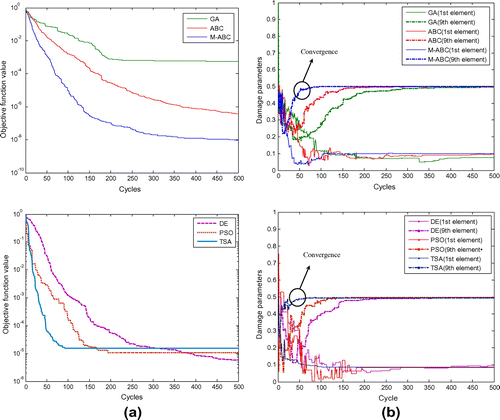
Table 3. Identified results of the damage parameters of case 1.
In addition, in practice, there would be possibility of errors due to measurement noise or/and modelling error in the measured responses of the system. In order to account for these errors in the measurements; normally distributed random noise can be added to the simulated responses data with zero mean and a variance of 1. The noise for responses can be incorporated by using the following equation
(15)
(15)
where is the ith measured response with noise, xi is the ith calculated response without noise, nl is the noise level for responses (e.g. 0.01 refers to a 1 percentage noise level). In this study, 1% uniform noise is added to the natural frequencies and 10% uniform noise is added to the modal shapes [Citation7]. The identified results are presented in Figure and Table . It can be seen that the present M-ABC can still detect the damages correctly with noisy measurements. The damage detection results are α1 = 0.0967and α9 = 0.4978 with the smallest standard deviations (3.2E-3 and 5.6E-4, respectively), which verifies that the identified damage parameters are very close to the true value. For the other algorithms, GA, DE, ABC and PSO seem to be affected by artificial noise markedly, one can point relative big errors of the 1st element. By contrast, the estimated errors for FA and TSA are 0.45 and 1.58%, respectively.
4.5. A cantilevered plate
The second example is a cantilevered plate structure as shown in Figure . The plate has dimensions of and its physical material properties of the plate are: Young’s modulus
, density
and Poisson’s ratio μ = 0.3. In the finite element, the plate was discretized into twenty-five four-node Reissner-Mindlin plate elements. Two damage scenarios are studied to further test the proposed method.
Figure 7. A cantilevered steel plate. Note: 1, 2,… , 36 denote node number of FEM; 1, 2,…, 25 denote element number.
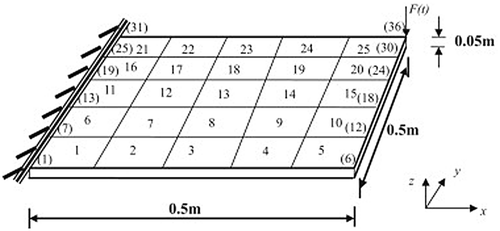
4.5.1. Case 2 single damage for the plate
Supposing the 1st element has 5% reduction in the Young’s modulus, considering the situation without noise. The first six natural frequencies and six mode shapes are utilized to identify damage and the parameters setting are the same as the beam case.
In this scenario, the whole evolutionary process of the objective function values are shown in Figure , the proposed algorithm can still obtain the smallest objective values while the convergence rate of TSA is quicker than that of DE and PSO. Moreover, the iteration process of the damage parameter is shown in Figure . In this case, convergence of M-ABC is quite fast (about 150 cycles) and final results are listed in Figure and Table . One can find that the modified ABC algorithm is able to estimate the correct values of the structural parameters in the noise free case even with partial measurements, whereas GA cannot identify the assumed damage. When the ABC algorithm is implemented, the estimated error of the 1st element is 0.02% but with eight false alarms. For the DE, PSO, TSA, they can acquire a satisfactory outcomes as well. In contrast, the outcome of damage element based on FA is 4.75%.
Figure 8. (a) Evolutionary process of objective function values of case 2 (without noise), (b) Evolutionary process of objective function values of case 2 (without noise).
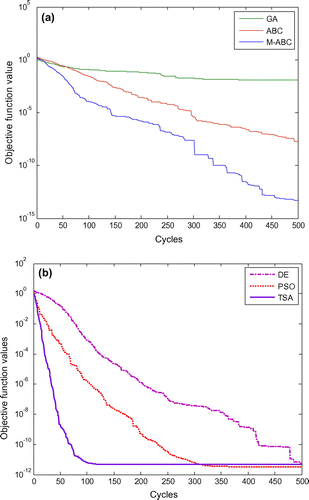
Table 4. Identified results of case 2.
4.5.2. Case 3 multiple damage for the plate
In this case, five local large damages are introduced into the plate, which locate at the 1st, 5th, 13th, 21st and 25th elements with a reduction in Young’s modulus by 15, 10, 8, 10 and 15%, respectively. The first six natural frequencies and six mode shapes are utilized to identify damage. Since GA cannot estimate the damage correctly in case 2, it does not plan to use GA to identify case 3. Figure (a) and (b) also presents the evolutionary process of the damage parameters. Similar with Figure , the TSA still reflects its quick convergence rate. For the M-ABC, it requires around 100 cycles to converge presetting values. In terms of identified precision, the suggested algorithm still acquires a more accuracy and stable result. As is shown in Figure and Table , the biggest estimated error is only 0.124%, occurring in 13th element. Considering the standard deviation, expecting the 21st element, the values of other four destructive elements using the proposed methods are the smallest. When 1% uniform noise is added to the natural frequencies and 10% uniform noise is added to the mode shapes, the M-ABC has the maximum error −0.99%, occurring in 13th element while the error got by TSA is −0.75%. However, for the other damaged elements, the suggested method acquired more competitive results. Final results are listed in Table and Figure .
Figure 11. (a) Evolutionary process of the damage parameters of case 3 (without noise), (b) Evolutionary process of the damage parameters of case 3 (without noise).
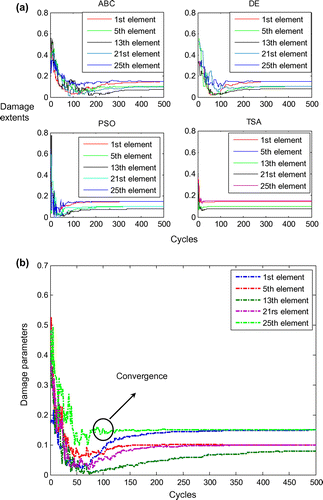
Table 5a. Identified results of case 3 (Without noise).
Table 5b. Identified results of case 3 (With noise).
5. Conclusions
Structural damage identification based on M-ABC algorithm and other swarm intelligence techniques using vibration data are investigated in this work. In the modified algorithm, a new formula is used to describe the behaviour of onlooker bee and thus improves the convergent rate and local search ability of ABC algorithm. And the Tournament Selection Strategy is also introduced to the original ABC algorithm to enhance the exploration ability further. The performance of the M-ABC algorithm is illustrated by test functions and two numerical examples. Studies show that the proposed M-ABC algorithm is efficient and robust for damage identification problem.
For further research, it can be extended as below
| • | In the numerical simulations, the structures used are relatively simple and easy and the complex structures including composite materials can be used for further research. | ||||
| • | As with the objective function, only frequency-domain parameters are used to investigate. In future, we can research about time response and even time-frequency response function. | ||||
| • | Besides, the experimental work can be operated to manifest its effectiveness and efficiency further. | ||||
Funding
This work was supported by the National Natural Science Foundation of China [11172333], [11272361]; Guangdong Province Natural Science Foundation [2015A030313126]; the Guangdong Province Science and Technology Program [2014A020218004], [2016A020223006].
Disclosure statement
No potential conflict of interest was reported by the authors.
References
- Doebling SW, Farrar CR, Prime MP. A summary review of vibration-based damage identification methods. Shock Vib Digest. 1998;30(2):91–105.10.1177/058310249803000201
- Koh BH, Dyke SJ. Structural health monitoring for flexible bridge structures using correlation and sensitivity of modal data. Comput Struct. 2007;85(3–4):117–130.10.1016/j.compstruc.2006.09.005
- Lu ZR, Law SS. Features of dynamic response sensitivity and its application in damage detection. J Sound Vib. 2007;303:305–329.10.1016/j.jsv.2007.01.021
- Li J, Hao H. Damage detection of shear connectors under moving loads with relative displacement measurements. Mech Syst Signal Process. 2015;60–61:124–150.10.1016/j.ymssp.2014.09.014
- Li J, Hao H, Fan K, et al. Development and application of a relative displacement sensor for structural health monitoring of composite bridges. Struct Control Health Monit. 2015;22(4): 726–742.
- Franco G, Betti R, Luş H. Identification of structural systems using an evolutionary strategy. J Eng Mech. 2004;130(10):1125–1139.10.1061/(ASCE)0733-9399(2004)130:10(1125)
- Kang F, Li JJ, Xu Q. Damage detection based on improved particle swarm optimization using vibration data. Appl Soft Comput. 2012;12:2329–2335.10.1016/j.asoc.2012.03.050
- Sun H, Luş H, Betti R. Identification of structural models using a modified Artificial Bee Colony algorithm. Comput Struct. 2013;116:59–74.10.1016/j.compstruc.2012.10.017
- Sinha JK, Friswell MI, Edwards S. Simplified models for the location of cracks in beam structures using measured vibration data. J Sound Vib. 2002;251(1):13–38.10.1006/jsvi.2001.3978
- Lee JH. Identification of multiple cracks in a beam using natural frequencies. J Sound Vib. 2009;320(3):482–490.10.1016/j.jsv.2008.10.033
- Friswell MI, Penny JET. A combined genetic and eigen sensitivity algorithm for the location of damage in structures. Comput Struct. 1998;69(5):547–556.10.1016/S0045-7949(98)00125-4
- Li RS, Mita A, Zhou J. Symbolization-based differential evolution strategy for identification of structural parameters. Struct Control Health Monit. 2013;20(10):1255–1270.10.1002/stc.v20.10
- Dackermann UI, Smith WA, Randall RB. Damage identification based on response-only measurements using cepstrum analysis and artificial neural networks. Struct Health Monit. 2014;13(4):430–444.10.1177/1475921714542890
- Guo HY, Li YL. Structural damage identification based on evidence fusion and improved particle swarm optimization. J Vib Control. 2014;20(9):1279–1292.10.1177/1077546312469422
- Karaboga D, Basturk B. A comparative study of Artificial Bee Colony algorithm. Appl Math Comput. 2009;214(1):108–132.
- Zhu GP, Kwong S. Gbest-guided Artificial Bee Colony algorithm for numerical function optimization. Appl Soft Comput. 2010;217:3166–3173.
- Banharnsakun A, Sirinaovakul B, Achalakul T. Job shop scheduling with the best-so-far ABC. Eng Appl Artif Intell. 2012;25(3):583–593.10.1016/j.engappai.2011.08.003
- Gao W, Liu S, Huang L. A novel Artificial Bee Colony algorithm based on modified search equation. IEEE T Syst Man Cy B. 2012;43(3):1011–1024.
- Kiran MS, Hakli H, Gunduz M, et al. Artificial Bee Colony algorithm with variable search strategy for continuous optimization. Inf Sci. 2015;300:140–157.10.1016/j.ins.2014.12.043
- Kiran MS, Gunduz M. A novel Artificial Bee Colony-based algorithm for solving the numerical optimization problems. Int J Innov Comput-Inf Control. 2014;8(9):6107–6122.
- Sonmez M. Artificial Bee Colony algorithm for optimization of truss structures. Appl Soft Comput. 2011;11(2):2406–2418.10.1016/j.asoc.2010.09.003
- Eom YS, Han SY. A new topology optimization scheme for nonlinear structures. J Mech Sci Technol. 2014;28(7):2779–2786.10.1007/s12206-014-0319-8
- Omkar SN, Senthilnath J, Khandelwal R, et al. Artificial Bee Colony for multi-objective design optimization of composite structures. Appl Soft Comput. 2011;11(1):85–97.
- Ata B, Coban R. Artificial Bee Colony algorithm based linear quadratic optimal controller design for a nonlinear inverted pendulum. In: International Conference on Advanced Technology & Sciences (ICAT’14), 2014 Aug 12–15; Antalya, Turkey. p. 47–52.
- Ata B, Coban R. Linear quadratic optimal control of an inverted pendulum using the Artificial Bee Colony algorithm. In: IEEE International Conference on Automation, Quality and Testing, Robotics; 2014 May 22–24; Cluj-Napoca, Romania. p. 31–34.
- Erçin Ö, Çoban R. Identification of linear dynamic systems using Artificial Bee Colony algorithm. Turk J Electr Eng Comp Sci. 2012;20(sup.1):1175–1188. DOI:10.3906/elk-1012-956
- Sun H, Betti R. Simultaneous identification of structural parameters and dynamic input with incomplete output-only measurements. Struct Control Health Monit. 2014;21:868–889.10.1002/stc.v21.6
- Perera R, Ruiz A. A multistage FE updating procedure for damage identification in large-scale structures based on multiobjective evolutionary optimization. Mech Syst Signal Process. 2008;22(4):970–991.10.1016/j.ymssp.2007.10.004
- Karaboga D, Gorkemli B. A quick artificial bee colony (qABC) algorithm and its performance on optimization problems. Appl Soft Comput. 2014;23:227–238.10.1016/j.asoc.2014.06.035
- Fu YZ, Lu ZR, Liu JK. Damage identification in plates using finite element model updating in time domain. J Sound Vib. 2013;332:7018–7032.
- Yang XS. Firefly algorithm, stochastic test functions and design optimisation. Int J Bio-Inspired Comput. 2010;2(2):78–84.10.1504/IJBIC.2010.032124
- Kiran MS. TSA: tree-seed algorithm for continuous optimization. Expert Syst Appl. 2015;42:6686–6698.10.1016/j.eswa.2015.04.055

